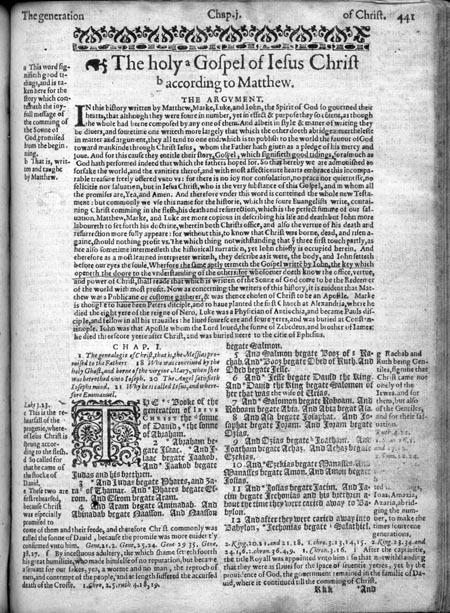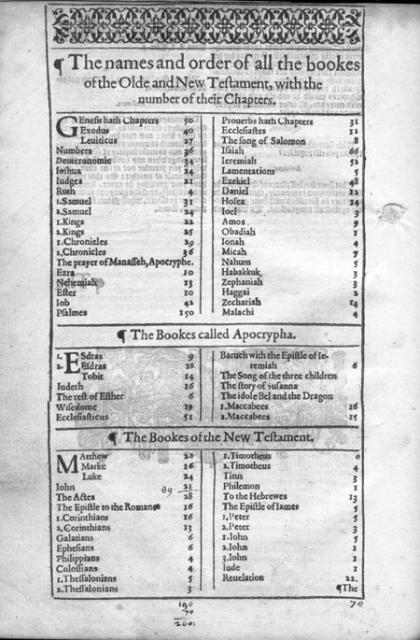
The Bible. London, Robert Barker, 1608. 2pl. 1-435 [i.e. 434] l., 4l., 441-554, [1-82] l. 22 cm.
During the religious persecutions of Queen Mary's reign, English Puritans sought refuge in Geneva, Switzerland, and wanted to produce an annotated Bible for the use of their families while in exile. In 1557, William Whittingham completed a New Testament, which included copious notes in the margins. It used Roman type instead of the traditional "Black Letter" for the first time in English Scriptures. Also for the first time, it had numbered verse divisions, following earlier French, Latin, Greek and Hebrew editions.
With this Testament off the press in Geneva, Whittingham, aided by Anthony Gilby and Thomas Sampson (all trained at Cambridge or Oxford), plunged into producing a similar text of the whole Bible, continuing the translation tradition begun by William Tyndale in 1525. They used the "Great Bible" translated by Miles Coverdale in 1539 as a point of departure. Corrections were based on improved Latin and Greek texts; elaborate notes covered historical or geographical explanations as well as moral lessons. Financed by the English congregation at Geneva, the Bible was first printed in Geneva in 1560. Royal permission was obtained from Queen Elizabeth for its printing in England. In the eighty-four years of its publication, some 140 editions of the Geneva Bible or New Testament were produced.
For three generations, this Bible held sway in the homes of the English people. While Great Bibles and Bishops' Bibles were read out in the churches, Geneva Bibles were read by the firesides, well before and after the King James version was issued. The Geneva Bible was the Bible of William Shakespeare, John Bunyan, and Oliver Cromwell. This is the version that Pilgrims and Puritans brought with them to America.
The Geneva version is often referred to as the "Breeches Bible" because of use of the word "breeches" in Gen. 3:7:
Then the eyes of both [Adam and Eve] were opened, and they knew that they were naked, and they sowed figge tree leaves together, and made themselves breeches.
Additional images:


Sources of information:
Pelikan, Jaroslav Jan. The Reformation of the Bible: The Bible of the Reformation. Catalog of the exhibition by Valerie R. Hotchkiss and David Price. New Haven: Yale University Press, c1996.
The Cambridge History of the Bible. Cambridge: University Press, 1963-70.
